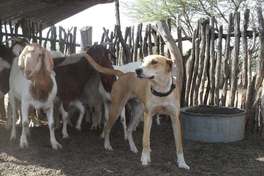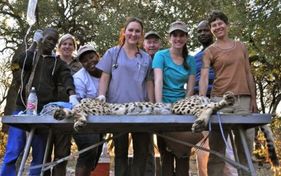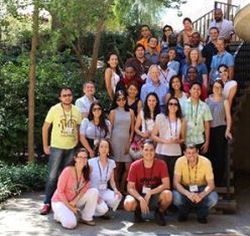
 CCB has been assigned by the Department of Wildlife and National Parks (DWNP) to participate in capacity building of rural farming populations through implementing and monitoring human wildlife coexistence strategies in Northern Botswana. These strategies include the use of guard dogs in protecting livestock against medium-sized predators. In 2014, CCB placed 36 puppies as small-stock guarding dogs in the Okavango, Boteti and Chobe areas. In August, CCB’s the community outreach team partnered with Maun Animal Welfare Society (MAWS) veterinary to provide sterilisations and vaccinations for all of the growing LSGDs. They are already having a great impact and 86% of the recipient farmers report that the young guarding dogs are willingly going out with their herds on a daily basis. Of these farmers, 100% are satisfied with their dogs. We wish both dogs and farmers all the best in reducing human wildlife conflict in the region!
0 Comments
 The second phase of collaring took place in August. We managed to deploy 7 collars in total. This will collect data on the mechanics of cheetah locomotion, hunting characteristics, and social interaction. The collars will be active and collecting data for the next 6 months, before automatically dropping off on a pre-programmed date in February. To facilitate downloading the data periodically, our partners at the Royal Veterinary College have devised innovative field download stations for deployment at each marking tree trapping site. A computer at the station can sense when a collared cheetah returns to the marking tree and will then automatically download the accumulated data from the collar. This should save us enormous amounts of time in data retrieval, as we only need to periodically service (and download from) each field station – rather than having to repeatedly track and find each cat in the field for proximity downloads. The download stations are solar powered and once erected, we surround them with thorny acacia braches to prevent hyenas and other overly-curious animals from disrupting or damaging them.  This course was sponsored by Conservation Strategy Fund (CSF) in partnership with the Stanford Woods Institute for the Environment and the Center for Conservation Biology at Stanford University (San Francisco, California). It was drafted to integrate fields in law, economics and natural sciences in addressing management mechanisms in conservation. The objective was designed to provide practical tools for formulating effective conservation programs and to combat problems of unsustainable and badly planned development projects. The highlight of the course was in helping the participants collect and analyse data, in ways that will help policy makers make informed decisions by teaching the language, which various stakeholders need to understand to see the value of the environment. This will be very useful for CCB as Mr. Phale Kgotla Phale who attended the course, will be integrating the tools learnt on his research projects, including sustainable management of natural resources. |
SearchArchives
May 2024
Categories |

 RSS Feed
RSS Feed
